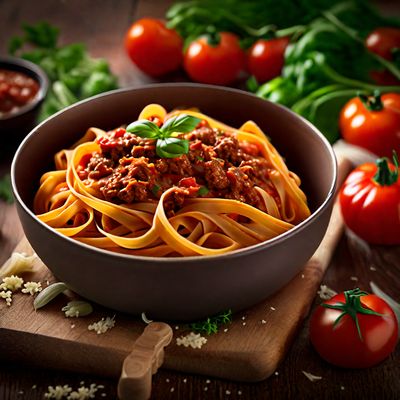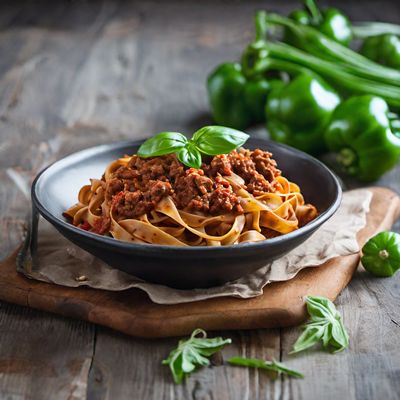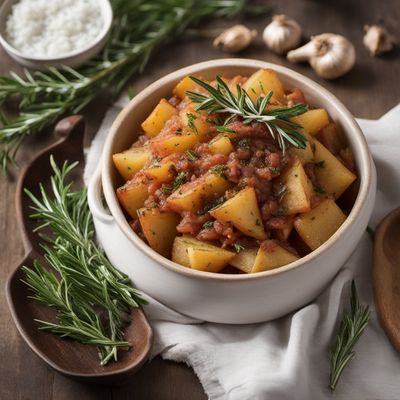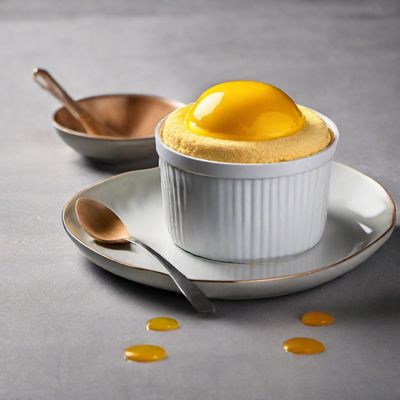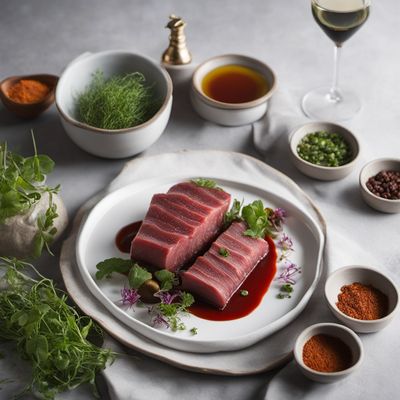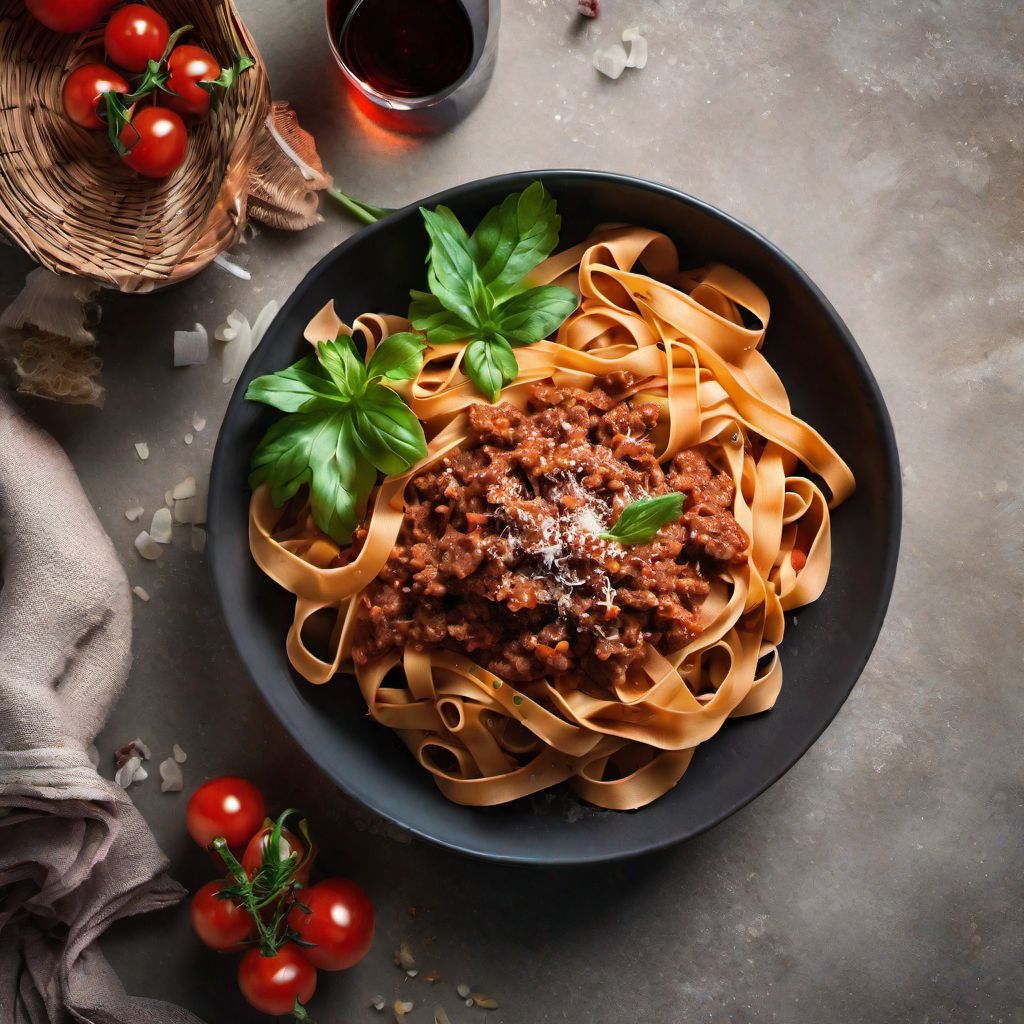
Recipe
Tagliatelle al ragù alla Bolognese - Molecular Gastronomy Style
Deconstructed Bolognese: Tagliatelle Ribbons with Molecular Ragu
4.8 out of 5
In the realm of molecular gastronomy, we reimagine the classic Italian dish, Tagliatelle al ragù alla Bolognese. This avant-garde adaptation combines innovative techniques and modern presentation to create a unique and visually stunning culinary experience.
Metadata
Preparation time
30 minutes
Cooking time
2 hours
Total time
2 hours 30 minutes
Yields
4 servings
Preparation difficulty
Medium
Suitable for
Omnivore, Low-carb, High-protein, Gluten-free (if using gluten-free pasta), Dairy-free (if omitting Parmesan cheese)
Allergens
Soy lecithin, Gluten (if using regular pasta), Dairy (if using Parmesan cheese)
Not suitable for
Vegetarian, Vegan, Paleo, Keto, Nut-free
Ingredients
While the traditional Tagliatelle al ragù alla Bolognese is a comforting pasta dish with a rich meat sauce, this molecular gastronomy version focuses on deconstructing the elements and presenting them in a visually striking manner. The flavors and essence of the original dish are preserved, but the presentation and techniques used are transformed. We alse have the original recipe for Tagliatelle al ragù alla Bolognese, so you can check it out.
-
200g (7 oz) beef, finely minced 200g (7 oz) beef, finely minced
-
100g (3.5 oz) pancetta, finely diced 100g (3.5 oz) pancetta, finely diced
-
100g (3.5 oz) carrot, finely diced 100g (3.5 oz) carrot, finely diced
-
100g (3.5 oz) celery, finely diced 100g (3.5 oz) celery, finely diced
-
100g (3.5 oz) onion, finely diced 100g (3.5 oz) onion, finely diced
-
50g (1.8 oz) tomato paste 50g (1.8 oz) tomato paste
-
250ml (1 cup) red wine 250ml (1 cup) red wine
-
500ml (2 cups) beef broth 500ml (2 cups) beef broth
-
2g (0.07 oz) xanthan gum 2g (0.07 oz) xanthan gum
-
5g (0.18 oz) soy lecithin 5g (0.18 oz) soy lecithin
-
200g (7 oz) fresh tagliatelle 200g (7 oz) fresh tagliatelle
-
Parmesan cheese, for garnish Parmesan cheese, for garnish
-
Fresh basil leaves, for garnish Fresh basil leaves, for garnish
Nutrition
- Calories (kcal / KJ): 450 kcal / 1884 KJ
- Fat (total, saturated): 20g, 7g
- Carbohydrates (total, sugars): 30g, 5g
- Protein: 35g
- Fiber: 5g
- Salt: 2g
Preparation
-
1.In a large pan, cook the minced beef and pancetta over medium heat until browned. Remove any excess fat.
-
2.Add the diced carrot, celery, and onion to the pan. Cook until the vegetables are softened.
-
3.Stir in the tomato paste and cook for a few minutes.
-
4.Pour in the red wine and let it simmer until reduced by half.
-
5.Add the beef broth and simmer for 1-2 hours, until the sauce has thickened and the flavors have melded together.
-
6.Meanwhile, prepare the tagliatelle according to package instructions. Drain and set aside.
-
7.To create the molecular ragu, combine the cooked ragu sauce with xanthan gum in a blender. Blend until smooth.
-
8.In a separate container, mix soy lecithin with water to create a foam.
-
9.Plate the dish by arranging the tagliatelle ribbons on a plate. Spoon the molecular ragu sauce over the ribbons.
-
10.Using a hand blender, create a foam with the soy lecithin mixture and spoon it over the ragu sauce.
-
11.Garnish with freshly grated Parmesan cheese and basil leaves.
Treat your ingredients with care...
- Beef — Choose lean beef for a healthier option and ensure it is finely minced for a smoother texture.
- Xanthan gum — Use a small amount to thicken the sauce without altering the taste.
- Soy lecithin — Follow the instructions on the package for creating a stable foam.
Tips & Tricks
- For a more intense flavor, let the ragu sauce simmer for a longer time.
- Experiment with different pasta shapes or even make your own homemade pasta.
- Adjust the thickness of the molecular ragu sauce by adding more or less xanthan gum.
- Serve the dish immediately after plating to maintain the foam's texture.
- Enhance the presentation by adding edible flowers or microgreens as a garnish.
Serving advice
Serve the deconstructed Bolognese dish on individual plates, allowing the vibrant colors and textures to shine. Encourage diners to mix the tagliatelle ribbons with the molecular ragu sauce and foam for a burst of flavors in each bite.
Presentation advice
Create an artistic presentation by carefully arranging the tagliatelle ribbons in a circular or wave-like pattern on the plate. Drizzle the molecular ragu sauce over the ribbons, allowing it to flow naturally. Top with the soy lecithin foam and garnish with freshly grated Parmesan cheese and basil leaves.
More recipes...
For Tagliatelle al ragù alla Bolognese » Browse all
For Italian cuisine » Browse all
More Italian cuisine dishes » Browse all

Struffoli
Struffoli is a traditional Italian dessert that is made with small balls of fried dough that are coated in honey and sprinkles. It is typically...

Salsiccia di Pignone
Pignone Sausage
Salsiccia di Pignone is a type of sausage that is made with pine nuts. It is a traditional Italian sausage that is typically served grilled or pan-fried.

Tomini elettrici
Electric Tomini
Tomini elettrici is a traditional Italian dish that is popular in the Piedmont region. It is a type of cheese that is fried and served hot.
